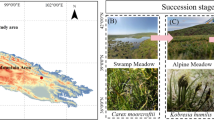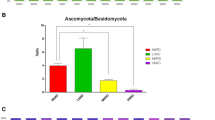Abstract
Sandy grassland restoration is a vital process including re-structure of soils, restoration of vegetation, and soil functioning in arid and semi-arid regions. Soil fungal community is a complex and critical component of soil functioning and ecological balance due to its roles in organic matter decomposition and nutrient cycling following sandy grassland restoration. In this study, soil fungal community and its relationship with environmental factors were examined along a habitat gradient of sandy grassland restoration: mobile dunes (MD), semi-fixed dunes (SFD), fixed dunes (FD), and grassland (G). It was found that species abundance, richness, and diversity of fungal community increased along with the sandy grassland restoration. The sequences analysis suggested that most of the fungal species (68.4 %) belonged to the phylum of Ascomycota. The three predominant fungal species were Pleospora herbarum, Wickerhamomyces anomalus, and Deconica Montana, accounting for more than one fourth of all the 38 species. Geranomyces variabilis was the subdominant species in MD, Pseudogymnoascus destructans and Mortierella alpine were the subdominant species in SFD, and P. destructans and Fungi incertae sedis were the dominant species in FD and G. The result from redundancy analysis (RDA) and stepwise regression analysis indicated that the vegetation characteristics and soil properties explain a significant proportion of the variation in the fungal community, and aboveground biomass and C:N ratio are the key factors to determine soil fungal community composition during sandy grassland restoration. It was suggested that the restoration of sandy grassland combined with vegetation and soil properties improved the soil fungal diversity. Also, the dominant species was found to be alternative following the restoration of sandy grassland ecosystems.





Similar content being viewed by others
References
Brodie, E., Edwards, S., & Clipson, N. (2003). Soil fungal community structure in a temperate upland grassland soil. FEMS Microbiology Ecology, 45, 105–114.
Cao, C. Y., Jiang, D. M., Teng, X. H., Jiang, Y., Liang, W. J., & Cui, Z. B. (2008). Soil chemical and microbiological properties along a chronosequence of Caragana microphylla Lam. plantations in the Horqin sandy land of Northeast China. Applied Soil Ecology, 40, 78–85.
Chapin III, F. S., Matson, P. A. & Vitousek, P. M. (2002). Principles of terrestrial ecosystem ecology. Springer.
Fracetto, G. G., Azevedo, L. C., Fracetto, F. J., Andreote, F. D., Lambais, M. R., & Pfenning, L. H. (2013). Impact of Amazon land use on the community of soil fungi. Scientia Agricola, 70, 59–67.
Gafan, G. P., Lucas, V. S., Roberts, G. J., Petrie, A., Wilson, M., & Spratt, D. A. (2005). Statistical analyses of complex denaturing gradient gel electrophoresis profiles. Journal of Clinical Microbiology, 43, 3971–3978.
Guo, Y. R., Zhao, H. L., Zuo, X. A., Drake, S., & Zhao, X. Y. (2008). Biological soil crust development and its topsoil properties in the process of dune stabilization, Inner Mongolia, China. Environmental Geology, 54, 653–662.
Harris, J. (2009). Soil microbial communities and restoration ecology: facilitators or followers? Science, 325, 573–574.
Hawksworth, D. L. (1997). The fascination of fungi: exploring fungal diversity. Mycologist, 11, 18–22.
Hawksworth, D. L. (2001). The magnitude of fungal diversity: the 1.5 million species estimate revisited. Mycological Research, 105, 1422–1432.
Hoshino, Y. T. 2012. Molecular analyses of soil fungal community-methods and applications. INTECH Open Access Publisher.
Hoshino, Y. T., & Morimoto, S. (2008). Comparison of 18S rDNA primers for estimating fungal diversity in agricultural soils using polymerase chain reaction-denaturing gradient gel electrophoresis. Soil Science & Plant Nutrition, 54, 701–710.
Jiang, D. M., Cao, C. Y., Zhang, Y., Cui, Z. B., & Han, X. S. (2014). Plantations of native shrub species restore soil microbial diversity in the Horqin Sandy Land, northeastern China. Journal of Arid Land, 6, 445–453.
Lauber, C. L., Strickland, M. S., Bradford, M. A., & Fierer, N. (2008). The influence of soil properties on the structure of bacterial and fungal communities across land-use types. Soil Biology and Biochemistry, 40, 2407–2415.
Lauber, C. L., Hamady, M., Knight, R., & Fierer, N. (2009). Pyrosequencing-based assessment of soil pH as a predictor of soil bacterial community structure at the continental scale. Applied and Environmental Microbiology, 75, 5111–5120.
Li, Y. L., Johnson, D. A., Su, Y. Z., Cui, J. Y., & Zhang, T. H. (2005). Specific leaf area and leaf dry matter content of plants growing in sand dunes. Botanical Bulletin of Academia Sinica, 46, 127–134.
Li, Y. Q., Brandle, J., Awada, T., Chen, Y. P., Han, J. J., Zhang, F. X., & Luo, Y. Q. (2013). Accumulation of carbon and nitrogen in the plant–soil system after afforestation of active sand dunes in China’s Horqin Sandy Land. Agriculture, Ecosystems & Environment, 177, 75–84.
Liu, R. T., Zhao, H. L., Zhao, X. Y., Zuo, X. A., & Drake, S. (2009). Soil macrofaunal response to sand dune conversion from mobile dunes to fixed dunes in Horqin sandy land, northern China. European Journal of Soil Biology, 45, 417–422.
Liu, J. J., Sui, Y. Y., Yu, Z. H., Shi, Y., Chu, H. Y., Jin, J., Liu, X. B., & Wang, G. H. (2015a). Soil carbon content drives the biogeographical distribution of fungal communities in the black soil zone of northeast China. Soil Biology and Biochemistry, 83, 29–39.
Liu, R. T., Zhao, H. L., Zhao, X. Y., & Liu, X. M. (2015b). Distribution of soil fauna in Horqin Sandy Land. Beijing: Science Press.
May, L. A., Smiley, B., & Schmidt, M. G. (2001). Comparative denaturing gradient gel electrophoresis analysis of fungal communities associated with whole plant corn silage. Canadian Journal of Microbiology, 47, 829–841.
Mueller, G. M., & Schmit, J. P. (2007). Fungal biodiversity: what do we know? What can we predict? Biodiversity and Conservation, 16, 1–5.
Nakatsu, C. (2007). Soil microbial community analysis using denaturing gradient Gel electrophoresis. Soil Science Society of America Journal, 71, 562–571.
Peay, K. G., Baraloto, C., & Fine, P. V. (2013). Strong coupling of plant and fungal community structure across western Amazonian rainforests. The ISME Journal, 7, 1852–1861.
Pellissier, L., Niculita Hirzel, H., Dubuis, A., Pagni, M., Guex, N., Ndiribe, C., Salamin, N., Xenarios, I., Goudet, J., & Sanders, I. R. (2014). Soil fungal communities of grasslands are environmentally structured at a regional scale in the Alps. Molecular Ecology, 23, 4274–4290.
Putten, W. H., Bardgett, R. D., Bever, J. D., Bezemer, T. M., Casper, B. B., Fukami, T., Kardol, P., Klironomos, J. N., Kulmatiski, A., & Schweitzer, J. A. (2013). Plant–soil feedbacks: the past, the present and future challenges. Journal of Ecology, 101, 265–276.
Sharma, D., Gosai, K., Dutta, J., Arunachalam, A., & Shukla, A. K. (2015). Fungal diversity of twelve major vegetational zones of Arunachal Himalaya, India. Current Research in Environmental & Applied Mycology, 5, 101–119.
Shirato, Y., Zhang, T., Ohkuro, T., Fujiwara, H., & Taniyama, I. (2005). Changes in topographical features and soil properties after exclosure combined with sand-fixing measures in Horqin Sandy Land, Northern China. Soil Science & Plant Nutrition, 51, 61–68.
Van Der Heijden, M. G. A., Bardgett, R. D., & Van Straalen, N. M. (2008). The unseen majority: soil microbes as drivers of plant diversity and productivity in terrestrial ecosystems. Ecology Letters, 11, 296–310.
Van Der Wal, A., Geydan, T. D., Kuyper, T. W., & de Boer, W. (2013). A thready affair: linking fungal diversity and community dynamics to terrestrial decomposition processes. Fems Microbiology Reviews, 37, 477–494.
Varela, A., Martins, C., Núñez, O., Martins, I., Houbraken, J. A. M. P., Martins, T. M., Leitão, M. C., McLellan, I., Vetter, W., Galceran, M. T., Samson, R. A., Hursthouse, A., & Silva Pereira, C. (2015). Understanding fungal functional biodiversity during the mitigation of environmentally dispersed pentachlorophenol in cork oak forest soils. Environmental Microbiology. doi:10.1111/1462-2920.12837.
Wang, T. (2003). Desert and desertification in China. Shijiazhuang: Heibei Science and Technology Publishing House.
Wang, G. H., Xu, Y. X., Jin, J., Liu, J. D., Zhang, Q. Y., & Liu, X. B. (2009). Effect of soil type and soybean genotype on fungal community in soybean rhizosphere during reproductive growth stages. Plant and Soil, 317, 135–144.
Wang, S. K., Zhao, X. Y., Qu, H., Zuo, X. A., Lian, J., Tang, X., & Powers, R. (2011). Effects of shrub litter addition on dune soil microbial community in Horqin Sandy Land, Northern China. Arid Land Research and Management, 25, 203–216.
Wang, S. K., Zhao, X. Y., Zuo, X. A., Liu, X. P., Qu, H., Mao, W., & Yun, J. Y. (2015). Screening of cellulose decomposing fungi in sandy dune soil of Horqin Sandy Land. Sciences in Cold and Arid Regions, 7, 74–80.
Wardle, D. A., & Lindahl, B. D. (2014). Disentangling global soil fungal diversity. Science, 346, 1052–1053.
White, T. J., Bruns, T., Lee, S., & Taylor, J. (1990). Amplification and direct sequencing of fungal ribosomal RNA genes for phylogenetic. In M. A. Innis, D. H. Gelfand, & J. J. S. J. White (Eds.), PCR protocols—a guide to methods and applications (pp. 315–322). San Diego: Academic.
Zhang, J. Y., Zhao, H. L., Zhang, T. H., Zhao, X. Y., & Drake, S. (2005). Community succession along a chronosequence of vegetation restoration on sand dunes in Horqin Sandy Land. Journal of Arid Environments, 62, 555–566.
Zhang, Q. M., Zhu, L. S., Wang, J., Xie, H., Wang, J. H., Wang, F. H., & Sun, F. X. (2014). Effects of fomesafen on soil enzyme activity, microbial population, and bacterial community composition. Environmental Monitoring and Assessment, 186, 2801–2812.
Zhao, H. L., Zhao, X. Y., Zhang, T. H., & Wu, W. (2003). Desertification processes and its restoration mechanisms in the Horqin Sand Land. Beijing: Ocean Press.
Zhao, X. Y., Wang, S. K., Luo, Y. Y., Huang, W. D., Qu, H., & Lian, J. (2015). Toward sustainable desertification reversion: a case study in Horqin Sandy Land of northern China. Sciences in Cold and Arid Regions, 7, 23–28.
Zhou, D. Q. (2002). A tutorial in microbiology. Beijing: Higher Education Press.
Zhou, X., Zuo, X. A., Zhao, X. Y., Wang, S. K., Liu, C., Zhang, J., Lv, P., & Zhang, J. P. (2015). Comparison analyses of DCA, CCA, DCCA on relationships between plant community distribution and soil peroperties of Horqin Sandy Land. Chinese Journal of Ecology, 34, 947–954.
Zhu, Z. D., & Chen, G. T. (1994). Sandy desertification in China. Beijing: Science Press.
Zuo, X. A., Zhao, X. Y., Zhao, H. L., Zhang, T. H., Guo, Y. R., Li, Y. Q., & Huang, Y. X. (2009). Spatial heterogeneity of soil properties and vegetation–soil relationships following vegetation restoration of mobile dunes in Horqin Sandy Land, Northern China. Plant and Soil, 318, 153–167.
Zuo, X. A., Zhao, X. Y., Wang, S. K., Li, Y. Q., Lian, J., & Zhou, X. (2012). Influence of dune stabilization on relationship between plant diversity and productivity in Horqin Sand Land, Northern China. Environmental Earth Sciences, 67, 1547–1556.
Acknowledgments
This work was financially supported by the National Nature Science Foundation of China (41401620 and 41271007), “One Hundred Talent” Program of Chinese Academy of Sciences (Y451H31001), and Major Scientific and Technological Special Project of Inner Mongolia (Y439K71001). We thank all the members of Naiman Desertification Research Station, CAS, for their help in our field and laboratory work. We are also grateful to the anonymous reviewers for their helpful comments.
Author information
Authors and Affiliations
Corresponding author
Rights and permissions
About this article
Cite this article
Wang, SK., Zuo, XA., Zhao, XY. et al. Responses of soil fungal community to the sandy grassland restoration in Horqin Sandy Land, northern China. Environ Monit Assess 188, 21 (2016). https://doi.org/10.1007/s10661-015-5031-3
Received:
Accepted:
Published:
DOI: https://doi.org/10.1007/s10661-015-5031-3




